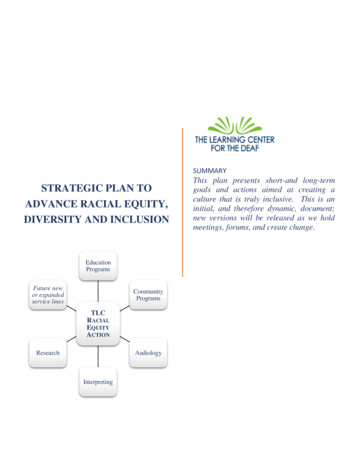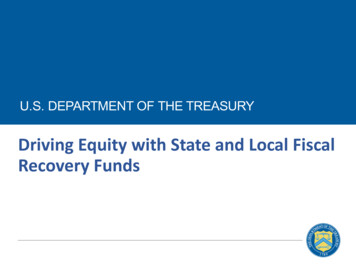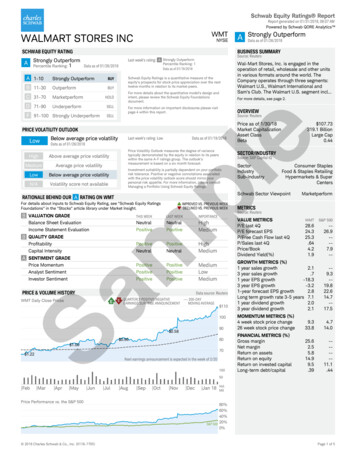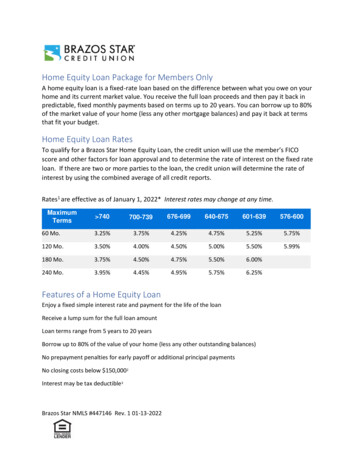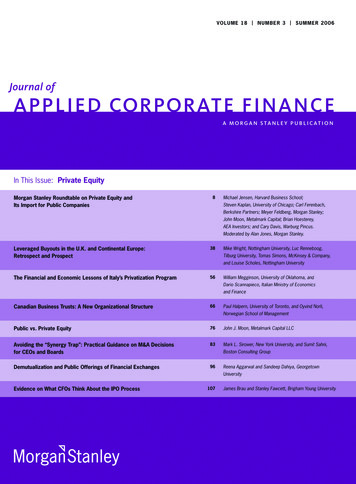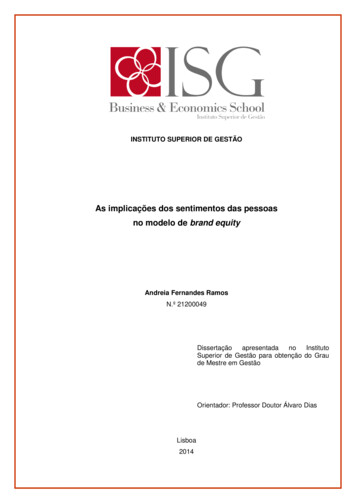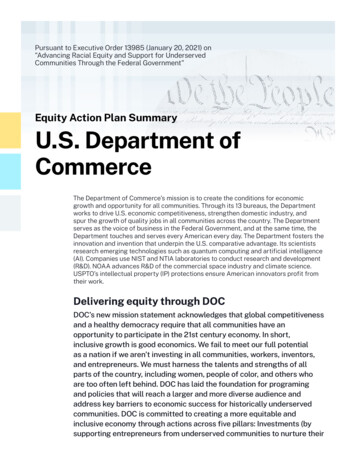
Transcription
Pursuant to Executive Order 13985 (January 20, 2021) on"Advancing Racial Equity and Support for UnderservedCommunities Through the Federal Government"Equity Action Plan SummaryU.S. Department ofCommerceThe Department of Commerce’s mission is to create the conditions for economicgrowth and opportunity for all communities. Through its 13 bureaus, the Departmentworks to drive U.S. economic competitiveness, strengthen domestic industry, andspur the growth of quality jobs in all communities across the country. The Departmentserves as the voice of business in the Federal Government, and at the same time, theDepartment touches and serves every American every day. The Department fosters theinnovation and invention that underpin the U.S. comparative advantage. Its scientistsresearch emerging technologies such as quantum computing and artificial intelligence(AI). Companies use NIST and NTIA laboratories to conduct research and development(R&D). NOAA advances R&D of the commercial space industry and climate science.USPTO’s intellectual property (IP) protections ensure American innovators profit fromtheir work.Delivering equity through DOCDOC’s new mission statement acknowledges that global competitivenessand a healthy democracy require that all communities have anopportunity to participate in the 21st century economy. In short,inclusive growth is good economics. We fail to meet our full potentialas a nation if we aren’t investing in all communities, workers, inventors,and entrepreneurs. We must harness the talents and strengths of allparts of the country, including women, people of color, and others whoare too often left behind. DOC has laid the foundation for programingand policies that will reach a larger and more diverse audience andaddress key barriers to economic success for historically underservedcommunities. DOC is committed to creating a more equitable andinclusive economy through actions across five pillars: Investments (bysupporting entrepreneurs from underserved communities to nurture their
companies at critical stages of development and growth); Capabilitiesand Knowledge Sharing (developing tools and resources for underservedentrepreneurs to successfully operate their companies); Opportunities(funding, training, and technical assistance programs and by establishingpartnerships so that underrepresented groups can contribute to theemerging technologies space); People (ensuring that people and familiescan thrive in their communities by realizing gains from their participationin the economy); and Service Delivery (Department services that aredata-driven and strengthened to meet the needs of underrepresentedgroups).
Equity Action Plan Summary: U.S. Department of CommerceNew strategies to advance equityClose the digital divideBroadband is an engine for opportunity in the modern economy and anecessary foundation for inclusive growth. Yet many Americans—anddisproportionately those living in rural areas, on tribal lands, and in lowincome communities—do not have access to reliable, affordable highspeed broadband nor the tools to use such services, and a digital dividepersists to this day. Maximizing broadband coverage and its meaningfuluse is imperative for national and individual success. To address thisbarrier, the Department will, through the National Telecommunications andInformation Administration (NTIA), administer nearly 50 billion in grantfunds to invest in broadband infrastructure deployment, affordability, anddigital inclusion efforts to help close the digital divide. The Departmentwill focus its investments, outreach, and related technical assistance onthose communities and other areas of the Nation that have largely beenleft behind in the digital revolution to ensure that all Americans have anopportunity to participate equitably in the modern digital economy. Thiseffort will focus on expanding affordable and reliable access to broadbandservice through direct grants and by expanding universal access throughstate and community level broadband grants.Ensure community development dollars advance racial equityand support underserved communitiesCommunities of color and rural communities face barriers when it comesto economic development and job creation. These barriers include: a lackof awareness of opportunities, whether of grant programs to supporteconomic development or technical assistance to aid in developing orimplementing an economic plan; capacity constraints on effectivelydeveloping and/or implementing economic development plans; inadequateaccess to resources, including funding, or a network to support effectiveplan implementation; and certain economic programs that unintentionallydisadvantage these communities because of the way the programs aredesigned, marketed or evaluated. To effectively address these challenges,DOC’s Economic Development Administration (EDA) will engage inequitable program design, including by being intentional in the design3
Equity Action Plan Summary: U.S. Department of CommerceNew strategies to advance equityof programs and Notices of Funding Opportunities; by being deliberatein outreach strategies to focus on reaching underserved populations bypartnering with different government and external parties to reach thesecommunities; by recruiting and selecting a diverse group of experiencedreviewers; and by providing technical assistance to grantees, includingfrom underserved communities to help ensure their success.Grow underserved business enterprisesGrowing underserved businesses enterprises can help to reduce theracial wealth gap, increase employment and opportunity in communitiesof color, and increase U.S. economic competitiveness. However, theseenterprises face systematic barriers to growth in the U.S. economy,including disproportionate impact from COVID-19; less access to capital;and contracting barriers at the prime and subcontractor levels. To addressthese barriers, the Minority Business Development Agency (MBDA) willexpand its services and reach to provide more underserved businesseswith one-on-one counseling and technical assistance to grow revenue andincrease employment, with special centers targeting assistance to specificindustries or services such as exporting, advanced manufacturing, andprocurement. MBDA will also provide technical assistance to underservedbusinesses accessing Treasury's State Small Business Credit Initiativeprogram to support incubators and programs to help firms developthe networks and experience to pitch investors. Through the FederalProcurement Center (FCP), MBDA will provide business services, including(but not limited to) the development of a pool of federal contractingopportunities; direct matching of opportunities with qualified/vettedunderserved businesses; relationship management, and deal sourcinginitiatives.Strengthen small businesses in underserved communities byhelping them be successful exportersHistorically, small American businesses in underserved communities havehad limited awareness of the opportunities and benefits of exporting andhave faced greater challenges to growing and adding new jobs. Some of4
Equity Action Plan Summary: U.S. Department of CommerceNew strategies to advance equitythose challenges include the requisite knowledge of export mechanics,financing, foreign legal and regulatory requirements, access to industryspecific market research, and avenues for meeting potential foreignpartners and clients. To address these barriers, DOC’s International TradeAdministration (ITA) has committed to doubling the number of clientsassisted in the next two fiscal years. ITA will focus on enhancing itsaccessibility and assistance to businesses in underserved communitiesand is targeting growth in the number of unique export clients assisted inunderserved communities.Increase access to patents for entrepreneurs from historicallyunderserved communitiesPatenting is an essential step in the innovation pipeline, allowingentrepreneurs to develop new products and driving the long-termcompetitiveness of an economy. Entrepreneurs from historicallyunderserved communities often face barriers to obtaining patents,including limited exposure and knowledge of the value of intellectualproperty (IP) protection and limited experience with the IP system. Recentresearch has demonstrated that the likelihood an individual will patent aninnovation is determined by socioeconomic factors like parental wealth,race, gender, and geography. In response, the U.S. Patent Office (USPTO)will undertake initiatives, which include initiating educational programs forHistorically Black Colleges and Universities (HBCUs), Tribal Colleges andUniversities (TCU), Hispanic Serving Institutions (HSIs), Minority ServingInstitutions (MSIs), women’s colleges and community colleges to providestudents and faculty with a train-the-trainer IP curriculum; by expandingits paid internship program for high schoolers to now add a program forcollege students that will also focus on equity; and by new measureswhich will alleviate the financial barriers to seeking IP assistance, via aclearinghouse to connect volunteer attorneys with independent trademarkholders/applicants or small business owners.5
Equity Action Plan Summary: U.S. Department of CommerceNew strategies to advance equityMake DOC science and data more findable, accessible, andusableThe Department’s bureaus and programs are well known to traditionalstakeholder groups, most of which have been working with the Departmentfor decades. However, DOC recognizes that underserved communities maylack awareness of and/or accessibility to some of its bureaus’ programsand services. DOC commits to leveraging cross-bureau and externalstrategic partnerships to drive a robust approach to engagement amongunderserved communities. Examples of this include the National Oceanicand Atmospheric Administration (NOAA) which will work across multipleprograms to enhance community engagement to ensure historicallyunderserved and socially vulnerable communities (HUSVC) can access thedata and programs needed to build climate resilience. Another exampleis that the National Institute of Standards and Technology (NIST) willwiden its educational outreach, including by participating in new industryforums, conferences, and meetings aimed at underserved communities,particularly emerging small- to medium-sized businesses. Finally, Censuswill continue to refine its recently launched CRE for Equity, a tool thatmeasures an individual, household or community’s capacity to absorb,endure, and recover from the socioeconomic impacts of a disaster.6
Equity Action Plan Summary: U.S. Department of CommerceBuilding on DOC's progressThis equity action plan builds on DOC's progress delivering onequity and racial justice in the first year of the Biden-HarrisAdministration.Expanding broadband accessIn August 2021, the National Telecommunications and InformationAdministration (NTIA) launched the Office of Minority BroadbandInitiatives (OMBI), which sits within the Office of Internet Connectivity andGrowth (OICG). The OMBI, authorized by Section 902 of the ConsolidatedAppropriations Act of 2021, was created to expand NTIA’s reach to engageHBCUs, TCUs, MSIs, and their surrounding anchor communities. NTIAalso provided support to approximately 300 individually identified tribes,prioritizing support for tribal organizations with limited or inadequateaccess to broadband as part of the Tribal Broadband Connectivity Program(TBCP). This resulted in over 300 applications (representing more than450 Federally recognized tribes) requesting nearly 6 billion in funds with 980 million available. NTIA prepared over 1,000 participants as potentialapplicants for the Connecting Minority Communities (CMC) Pilot Program,which received more than 200 applications with requests totalingapproximately 833 million in funding (with 268 million available).Launching the Council for Inclusive InnovationThe United States Patent and Trade Office (USPTO) launched the Councilfor Inclusive Innovation (CI2) under the chairmanship of DOC SecretaryGina Raimondo, which is designed to help develop a comprehensivenational strategy to build a more inclusive innovation ecosystem.Strengthening the Minority Business Development AgencyOn November 15, 2021, the President signed the Minority BusinessDevelopment Act of 2021 (Division K – Infrastructure Investment andJobs Act PL. 117-58). The Act codifies the Minority Business DevelopmentAgency (MBDA) within the Department of Commerce and appoints anUnder Secretary to lead MBDA. With newly granted authorities andresources, MBDA will expand programs in geographic regions and7
Equity Action Plan Summary: U.S. Department of CommerceBuilding on DOC's progresscommunities where MBDA has not been present; better inform the agencyand the federal government about the needs of underserved businesses,establishing capital forums and an advisory council; and serve as thefederal government’s go-to resource on all matters related to underservedbusinesses. The Act states that MBDA will be the federal coordinationhub of all programs dedicated to underserved businesses, such asprocurement and contracting. MBDA awarded approximately 10 millionunder the CARES Act in funding to thirty business and specialty centers,which reached nearly one million small and minority businesses – securingover 1,500 loans valued at 28.9 million, including Paycheck ProtectionProgram (PPP) Loans and Economic Injury Disaster Loans (EIDL). In FY21,MBDA assisted minority-owned businesses in thirty-eight states andPuerto Rico in securing 2 billion in contracts and 708 million in financingand supported the creation and retention of nearly 14,000 jobs.Launching the Global Diversity Export InitiativeThe International Trade Association established the Global DiversityExport Initiative (GDEI), consisting of over 40 participants, to promoteexport solutions to reach underserved communities by leveraging thebureau’s export assistant value chain and global network of offices withtrade experts in more than 100 cities and 75 overseas markets.Enhancing diversity in manufacturingThe National Institute of Standards and Technology (NIST) awardedfunding to the Iowa Manufacturing Extension Partnership (MEP) Centerand three additional MEP Centers via the Program Office CompetitiveAward Program for a project titled “Enhancing Diversity in Manufacturing’’that will increase student participation in industry internships acrossminority-serving institutions (MSI) – placing up to eight interns in the firstyear and up to sixteen interns in the second year.8
Equity Action Plan Summary: U.S. Department of CommerceBuilding on DOC's progressStrengthening civil rightsThe Secretary charged the Office of Civil Rights (OCR) with theresponsibility of enforcing internal and external DEIA policies andpractices at the department level. In support of this charge, DOC iscurrently developing a Departmental Administrative Order, which OCR willbe responsible for enforcing, that will require bureaus to conduct regularequity assessments, which will focus on external service delivery.Supporting business networks in underserved communitiesThe Bureaus of Industry and Security (BIS) leveraged the BIS Diversity,Equity, and Inclusion Council to nurture networks within underservedcommunities, such as Penn State’s National Society of Black Engineersand the Hispanic Association of Colleges and Universities. DOC alsopartnered with the Government Printing Office and Office of ExporterServices to produce web-based diversity forward assets, which reflecta more diverse workplace – to include documents like export servicesupporting materials that are provided in secondary languages, such asSpanish.Advancing program accessThe National Oceanic and Atmospheric Administration (NOAA) amendedprogram operations for the Sea Grant Program to include using moreinclusive language in national-level communications regarding fellowshipand funding opportunities, establishing a sub-committee on social justiceand resiliency as part of the National Sea Grant Advisory Board, initiatingthe Coastal, Ocean, and Marine Enterprise Inclusion and Network-BuildingProgram to foster peer learning among students and professionals.9
Equity Action Plan Summary: U.S. Department of CommerceBuilding on DOC's progressLeveraging Census data for equityCensus launched a new “Data for Equity” webpage and CommunityResilience Estimates (CRE) for Equity dataset, which allows usersquick access through an interactive tool to data about census tracts tomeasure social vulnerability and equity gaps across three different datasources – to include CRE, the American Community Survey and CensusPlanning Database. Additionally, an array of agencies across the federalgovernment, such as the Federal Emergency Management Agency,U.S. Department of Health and Human Services, and U.S. Departmentof Agriculture, have utilized the available data equity tools and trainingmaterials that are located on the webpage.10
MBDA assisted minority-owned businesses in thirty-eight states and Puerto Rico in securing 2 billion in contracts and 708 million in financing and supported the creation and retention of nearly .
